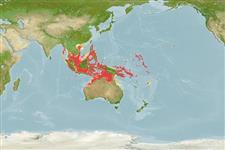Common names from other countries
>
Eupercaria/misc (Various families in series Eupercaria) >
Lutjanidae (Snappers) > Lutjaninae
Etymology: Lutjanus: Malay, ikan lutjan, name of a fish.
More on authors: Quoy & Gaimard.
Environment: milieu / climate zone / depth range / distribution range
Ecologia
marino associati a barriera corallina; distribuzione batimetrica 20 - 150 m (Ref. 90102). Tropical; 21°N - 20°S, 92°E - 177°W (Ref. 55)
Western Pacific: Iriomote Island, Okinawa Prefecture, Japan; Fiji to Malay Peninsula. Also recorded from the Andaman Sea off Thailand. This species has been frequently confused with other red snappers, particularly Lutjanus malabaricus.
Size / Peso / Age
Maturity: Lm ? range ? - ? cm
Max length : 73.7 cm FL maschio/sesso non determinato; (Ref. 125599); common length : 30.0 cm TL maschio/sesso non determinato; (Ref. 55); peso massimo pubblicato: 6.7 kg (Ref. 125599)
Spine dorsali (totale) : 11; Raggi dorsali molli (totale) : 14 - 15; Spine anali: 3; Raggi anali molli: 8. Dorsal profile of head steeply sloped. Preorbital width greater than eye diameter. Preopercular notch and knob poorly developed. Scale rows on back rising obliquely above lateral line. Axil of pectoral fin black. Young with a blackish or brownish band from upper jaw to the beginning of dorsal fin and a black saddle preceded by a pearly-white border on upper edge of caudal peduncle; horizontal stripes on sides (Ref. 469). Body depth 2.2-2.4 in SL (Ref. 90102).
Adults inhabit coral and rubble reefs. Usually solitary. Juveniles on muddy coastal slopes on open substrates with small outcrops of reef debris, usually in depth of 15 m or more (Ref. 48635). Relatively uncommon (Ref. 9710).
Life cycle and mating behavior
Maturities | Riproduzione | Spawnings | Egg(s) | Fecundities | Larve
Allen, G.R., 1985. FAO Species Catalogue. Vol. 6. Snappers of the world. An annotated and illustrated catalogue of lutjanid species known to date. FAO Fish. Synop. 125(6):208 p. Rome: FAO. (Ref. 55)
IUCN Red List Status (Ref. 130435)
CITES (Ref. 128078)
Not Evaluated
Threat to humans
Harmless
Human uses
Pesca: scarso interesse commerciale
Strumenti
Special reports
Download XML
Fonti Internet
Estimates based on models
Preferred temperature (Ref.
115969): 23.9 - 28.4, mean 27.3 (based on 578 cells).
Phylogenetic diversity index (Ref.
82804): PD
50 = 0.5000 [Uniqueness, from 0.5 = low to 2.0 = high].
Bayesian length-weight: a=0.01413 (0.00864 - 0.02310), b=3.04 (2.91 - 3.17), in cm Total Length, based on LWR estimates for this species & Genus-body shape (Ref.
93245).
Trophic level (Ref.
69278): 4.0 ±0.66 se; based on food items.
Resilienza (Ref.
120179): Basso, tempo minimo di raddoppiamento della popolazione 4.5 - 14 anni (Preliminary K or Fecundity.).
Fishing Vulnerability (Ref.
59153): Moderate vulnerability (39 of 100).
